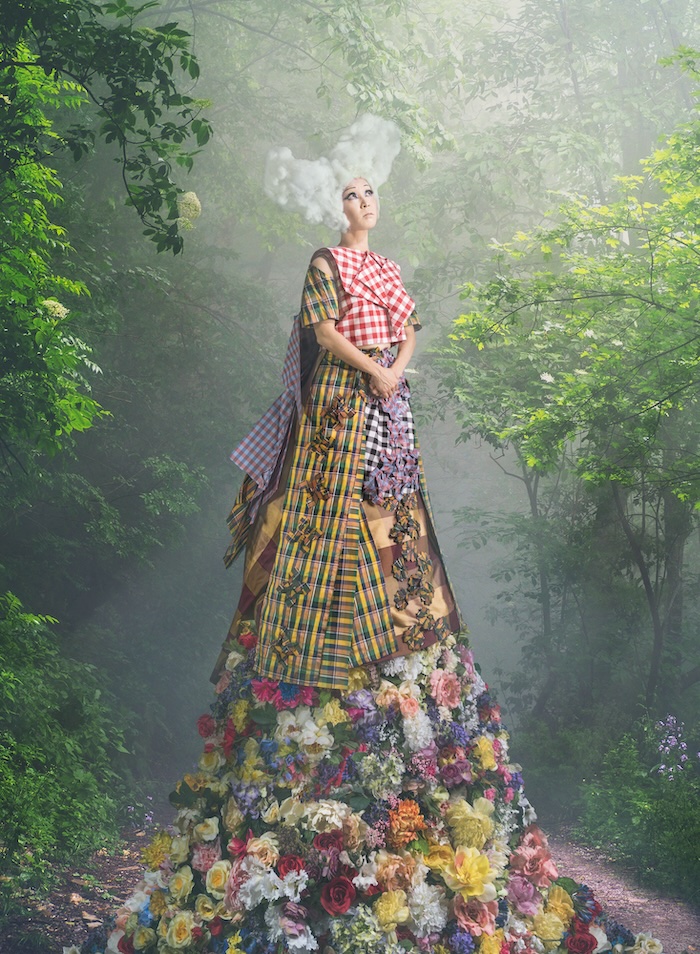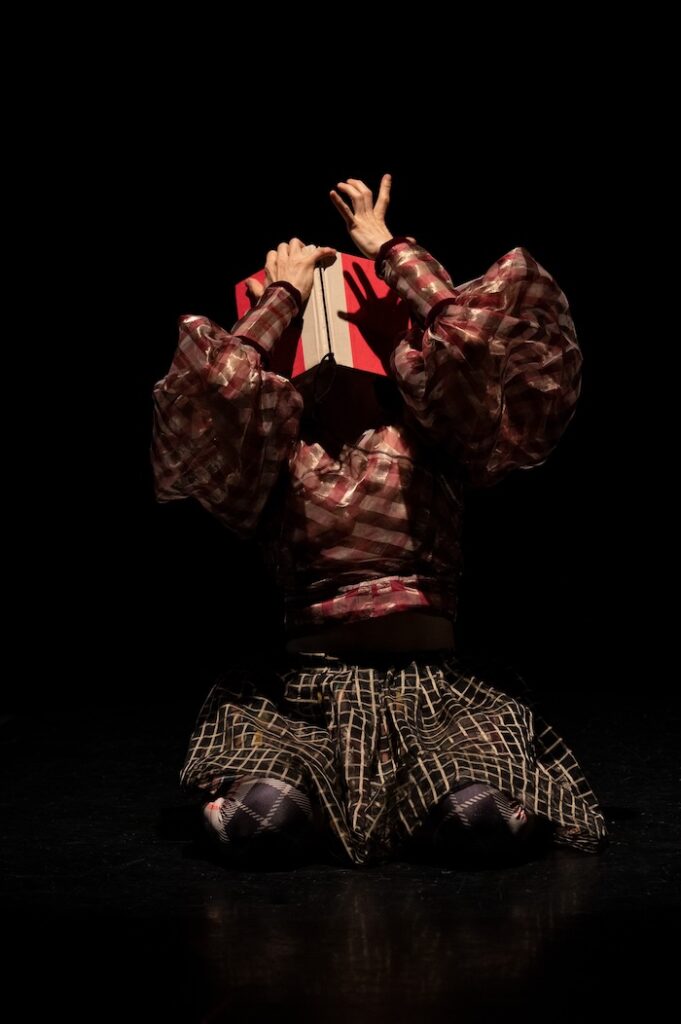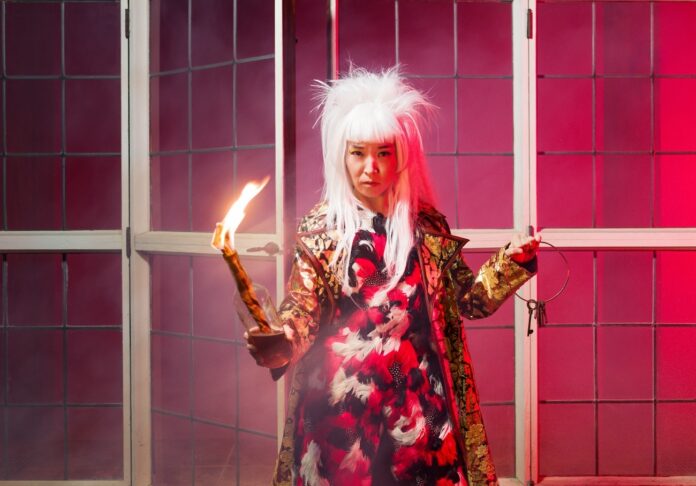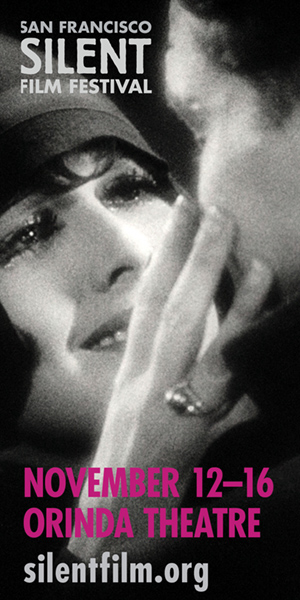Multifaceted performance company Degenerate Art Ensemble (DAE) may have taken their name from Hitler’s notorious “Degenerate Art Exhibition”—staged in Munich in 1937 as a counterpoint to his “Great German Art Exhibition”—but their shared truths go back much farther.
The same societal frailties exposed by artists for millennia, which upended the Nazi dictator (and failed art student)’s idealized view of a master race, are what Seattle’s DAE unmask in their unique Butoh-inspired dance productions.
Their first show, 1999’s Scream!LionDogs, was incited by the 1992 killing of an Asian American teenager by neo-Nazi skinheads in nearby Olympia, WA, and energized by the 1999 Seattle WTO protests against economic globalization.
For their latest piece to come to San Francisco, Skeleton Flower (ODC Theater; Fri/15-Sun/17), the company surfaces truths about sexual abuse, which one in three women worldwide experience over their lifetime. With many cases still going unreported, the number is believed by experts to be significantly higher.
Japan’s skeleton flower, whose white petals become transparent when wet, revealing the support structures inside, is the perfect metaphor for confronting DAE’s artistic director-dancer Haruko Crow Nishimura’s own sexual traumas and reclamation of her personal power.
She sets parts of her semi-autobiographical story in the worlds of three pivotal fairytales from her childhood—Fitcher’s Bird, The Wild Swans, and The Red Shoes—and casts her oppressors as kaiju-size monsters.
“The feeling of this piece is an invitation to a ceremony that strives to find a path from personal struggle to universal communion and back,” says Nishimura. “It invites the audience to experience bare reality while traveling to other dimensions where the soul does its work. It confronts the darkness, but there are many twists—and even humor along the way.”
I spoke to Nishimura and DAE’s creative producer Joshua Kohl about developing Skeleton Flower, confronting past trauma, and how “through difficulty and struggle,” we “can truly appreciate beauty.”
Help us save local journalism!
Every tax-deductible donation helps us grow to cover the issues that mean the most to our community. Become a 48 Hills Hero and support the only daily progressive news source in the Bay Area.
48 HILLS How did you develop the choreography and music for this production? What kind of energy were you aiming for?
HARUKO CROW NISHIMURA Because this work is autobiographical, it pulls some elements, characters, and concepts from the past. One of the fairytales was the subject of an entire past project. Mothra (embodying my mother) has paid me visits in several of my pieces. My work is developed initially through an enormous amount of improvisation alongside Joshua’s live music. They are sculpted and reworked into a fixed form through a long process.
JOSHUA KOHL Making the music and sound for Skeleton Flower was an enormous challenge. We were dealing with heavy emotional moments in the show, and I wanted to honor them in all of their uncomfortableness. But at the same time, I knew I had to find a counterbalance that would soothe and reassure—as if to say, “We are going to make it out alive.”
For this, I cowrote with Crow a song for each of the three fairytales that could be considered conventional songs. The show needed this kind of release. And these songs have been the soundtracks for cinematic tellings of the three fairytales. Some parts are womblike—allowing the viewer to catch their breath; others are chaotic, throwing the viewer into the frantic moment.
It is a sonic balancing act that helps with the push and pull of the storytelling to support and move the viewer forward. In this piece, I use a combination of guitar, electronics, and an instrument that I built that contains a harp, violin, and spring percussion. I also get to rock out a lot, which is super fun.

48 HILLS How did fairytales like The Fitcher’s Bird, The Wild Swans, and The Red Shoes impact you growing up?
HARUKO CROW NISHIMURA When I was a child, my mother read these stories to me, and she would continually cry. It left a deep impression on me, but there was a “clue” in these stories.
In Japanese culture, especially in the time of my childhood, an understanding of trauma and abuse didn’t exist. My mother had this unspoken underlying suffering that even she didn’t have a way to articulate. Yet these stories brought these energies to the surface.
My mother and grandmother both had arranged marriages, and my grandmother was a very shut-down person. There was an enormous amount of shame and erasure of women’s suffering in my ancestry.
The characters’ struggles for autonomy, expression, and becoming full beings seemed to trigger something inside of my mother. And in her case, it manifested as a great desire for creativity. Ironically, it was my creative desires that she continually shut down and forbade. As a child, I was taking note of something significant hidden there.
48 HILLS: What did these “clues” help you discover?
HARUKO CROW NISHIMURA The main characters in our three fairytales were misunderstood. We felt that the protagonist of Hans Christian Andersen’s The Red Shoes is a seriously doomed character. She is cursed to dance herself to death for following her desires. She ends up having her legs amputated, asking for forgiveness, and then dying.
Andersen took old orally transmitted folktales and playfully bent them to his ideological purposes. So we chose to unbend or playfully rebend them. In our take, the girl fights her way through the desires, through the critical eye of the village, and then, even after having her legs removed, she keeps dancing and finds her path. Similarly, butoh dance is a liberation of expression.
The Red Shoes is one of the three that we chose to alter. We have dear friends who have extreme disabilities and have found profound depths of expression through butoh, which many traditional forms would never allow or make space for. We can find realization by following our creative desires.
The protagonists of The Wild Swans and Fitcher’s Bird (both created/adapted by the Brothers Grimm) face enormous obstacles and oppression but divine their magic and creativity and find self-realization and autonomy. These offer clues about how important it is to be able to make mistakes and keep forging forward by being creative.
48 HILLS Were these perilous tales blueprints for navigating your personal trauma?
HARUKO CROW NISHIMURA It is very much like facing trauma and depression. It is a messy process filled with all kinds of obstacles that we have to overcome. We have to find ways to find joy, express ourselves, and build a life that can sustain us despite the past.
In the piece, there is a recurring poem about walking the path of our mothers and grandmothers and honoring them but trying to work through their blockages to choose a new path for our lives.

48 HILLS You’ve said the show “conjures” and “consoles” your female ancestors through hand-felted wools, hand-painted silk flowers, and knitted sweaters. How so?
HARUKO CROW NISHIMURA The show is wrapped in love. The Godzilla family, for example, is a horrific (and somewhat comical) scene. We see these kaiju battling in Tokyo, but their faces are made of hand-felted wool, and their clothing is hand-dyed and stitched. We infused the costumes with deep love, care, and texture.
I collaborated on all of these costumes. Dozens of these carefully crafted costumes were created for the different cinematic scenes by a small army of volunteers who supported our costume artists, using these materials to express care and comfort for every character and manifestation.
There is an unspoken meaning in materials. They are nostalgic and comforting and give us a sense of security. So costumes became integral to the ceremony, creating a safe and beautiful space to tell challenging stories.
48 HILLS When people experience trauma, they can run from it or confront it. How do you confront it multiple times (in writing, producing, and enacting the show) without being retriggered?
HARUKO CROW NISHIMURA Honestly, I get retriggered. But we take it one step at a time, just like athletes with injuries to overcome. We work it through, change it up, and practice self-care. And this care extends to our entire team. The fact that we can be retriggered means we have more work to do.
What keeps us going is that we are dealing with it—and it is changing everything in our lives. When we continue to do this work, it has a butterfly-like opening effect on our relationships and everyone around us.
We hope to bring care to the theater that hosts us and extend that care outward in every direction. It is a difficult piece for any audience to come to, but we take great care in making it a safe place for them. We think about our audience and their experience a lot.
48 HILLS How do you keep abuse survivors in your audience from getting overwhelmed?
HARUKO CROW NISHIMURA We can’t promise they won’t be overwhelmed. In our experience, our shows can be overwhelming. But we try to bring a balance of aesthetic beauty, humor, and warmth that keeps people grounded in the experience. Of course, everyone’s capacity for this is different and changing, and we try to honor that. We aim to create something that awakens and shakes, so we are accustomed to people having strong reactions. But we hope that it evokes something and gives people something to process. If so, we have done our job.
JOSHUA KOHL While Skeleton Flower contains a good deal of darkness, it is through navigating that darkness that one can find authentic light. Our society needs to look at things in this nuanced way.
It is heartbreaking when so many people see people sleeping on the street in winter and can only ask themselves, “How do we clean this up,” rather than how can we help these people navigate their real and immediate difficulties?
This truth is important, and, for us, play, fantasy, and joy are equally important to this tremendous adventure that the creative process can be. We cherish the freedom to use every color and every material in a way that brings awe and joy. It is through difficulty and struggle that we can truly appreciate beauty.
SKELETON FLOWER Fri/15-Sun/17, ODC Theater, 3153 17th St., SF. $44-$104. More info here.




